calsfoundation@cals.org
Bonnie and Clyde
aka: Barrow Brothers
aka: Barrow Gang
Arkansas was frequented by Bonnie Parker, Clyde Chesnut Barrow, and their associates, collectively known as the Barrow Gang, between 1932 and 1934. The gang’s criminal exploits in Arkansas included murder, attempted murder, kidnapping, robbery, and automobile theft. Western Arkansas was also on the circuit of back roads Clyde Barrow used to evade lawmen from other states. The most serious crime committed in the state by the Barrow Gang was the murder of Marshal Henry D. Humphrey of Alma (Crawford County), committed while the gang was hiding out in a tourist camp in Fort Smith (Sebastian County) in June 1933.
Bonnie Parker (October 1, 1910–May 23, 1934) and Clyde Barrow (March 24, 1909–May 23, 1934) both grew up in poverty in Texas. Parker was already married when they met in 1930, and she never divorced her husband. Some sources have it that they met at a friend’s house, while others claim they met at a restaurant at which Parker was working. At the time of their meeting, Barrow had already committed a number of robberies in the Dallas area. After his release from prison in 1932, Barrow and Parker began robbing grocery stores, filling stations, and small banks.
The Barrow Gang, which dated to Barrow’s 1932 release, included at one time or another Clyde’s brother Marvin “Buck” Barrow, Marvin’s wife Blanche (Caldwell) Barrow, Raymond Hamilton, Henry Methvin, and William Daniel (W. D.) Jones. In their total of two years of criminal activity, members of the group were responsible for twelve murders, the majority of them of law enforcement officers. In April 1933, they stole a car in Louisiana and then kidnapped the owner and his friend, who had chased them down. They then drove over the state line to near Waldo (Columbia County) in southwestern Arkansas and let them out, keeping the car. Most accounts of this story have either Bonnie or Clyde giving the pair five dollars to get back home.
On June 10, 1933, Barrow drove into a ravine near Wellington, Texas, overturning the car. No one else was hurt, but Parker sustained extensive burns to her leg. After being helped by a nearby farmer and his wife, the group captured two local officers, stole their car, and fled to Fort Smith, arriving on June 15. Although newspapers at the time give their Fort Smith hideout as the Twin City Tourist Camp, most evidence supports them having stayed at the nearby Dennis Tourist Camp, where Bonnie received medical care from the daughter of its owner, Sid Dennis. In excruciating pain, Parker slipped in and out of consciousness, and Barrow rarely left her side. The group was running low on cash, and it fell to Buck Barrow and W. D. Jones to obtain funds. On June 23, while returning from Fayetteville (Washington County) after robbing the R. L. Brown Grocery Market, Barrow and Jones encountered Alma Marshal Henry D. Humphrey and Crawford County Deputy Sheriff Ansel “Red” Salyers on Highway 71 north of Alma. In the ensuing exchange of gunfire Humphrey was shot in the chest, and he died three days later in a local hospital. The members of the Barrow Gang and Parker’s sister Billie narrowly escaped that night to Oklahoma and then to Kansas. A plaque on the grounds of the City Complex Building in Alma commemorates Humphrey’s death.
The Barrow Gang also committed a robbery in Texarkana (Miller County) and kidnapped an Arkansas man near Berryville (Carroll County). The Saunders Gun Museum in Berryville displays a hat reportedly worn by Clyde Barrow during a bank robbery.
On the morning of May 23, 1934, Barrow and Parker drove into a trap set by law officers (with the help of Henry Methvin of the Barrow Gang) near Gibsland, Louisiana. They were shot repeatedly and died at the scene. On the so-called death car was a stolen 1934 Arkansas license plate with the number 15-368. The bodies were taken to Arcadia, Louisiana, where thousands came to view them. Parker was buried in Fishtrap Cemetery in west Dallas, but in 1945 her gravesite was moved to the Crown Hill Cemetery in Dallas. Barrow is buried in the Western Heights Cemetery in western Dallas.
The Barrow Gang was among a small number of Depression-era outlaws who made headlines across the country. Then, as now, sources tended to disagree on many of the specifics of their movements and criminal activities. Although the group likely netted no more than $1,500 from any one robbery, the romance between Parker and Barrow made them of particular interest to newspaper readers at the time. Photographs of themselves and poems written by Parker left behind when fleeing authorities, as well as their violent and dramatic deaths, added to their mystique. They have been the subject of a number of movies, most notably 1967’s Bonnie and Clyde, starring Faye Dunaway and Warren Beatty in the title roles.
For additional information:
“Clyde Barrow Gang Visits Carroll County.” Carroll County Historical Quarterly 19 (Summer–Fall 1974): 7–8.
Knight, James R. “Incident at Alma: The Barrow Gang in Northwest Arkansas.” Arkansas Historical Quarterly 56 (Winter 1997): 399–426.
Long, Christopher. “Clyde Chesnut Barrow.” Handbook of Texas Online. https://www.tshaonline.org/handbook/entries/barrow-clyde-chesnut (accessed March 16, 2023).
Strickland, Kristie. “Bonnie Parker.” Handbook of Texas Online. https://www.tshaonline.org/handbook/entries/parker-bonnie (accessed March 16, 2023).
Jill Curran
Little Rock, Arkansas
 Early Twentieth Century, 1901 through 1940
Early Twentieth Century, 1901 through 1940 Law
Law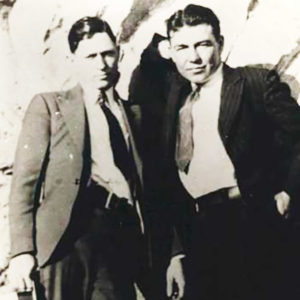 Barrow and Jones
Barrow and Jones 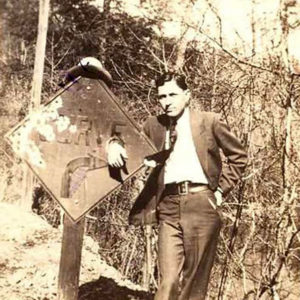 Barrow, Clyde
Barrow, Clyde 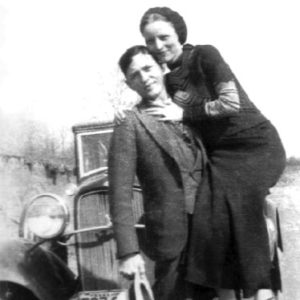 Bonnie and Clyde
Bonnie and Clyde  Bonnie and Clyde "Death Car" Handbill
Bonnie and Clyde "Death Car" Handbill 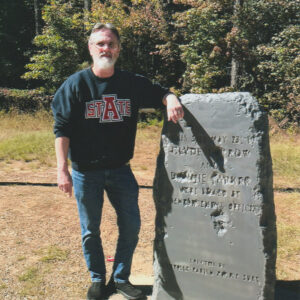 Bonnie and Clyde Ambush Monument
Bonnie and Clyde Ambush Monument 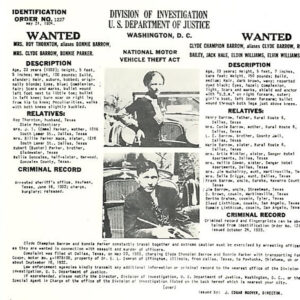 Bonnie and Clyde Wanted Poster
Bonnie and Clyde Wanted Poster 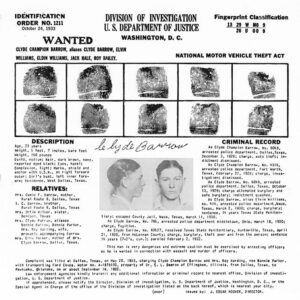 Clyde Barrow Wanted Poster
Clyde Barrow Wanted Poster  Bonnie Parker
Bonnie Parker 




Comments
No comments on this entry yet.